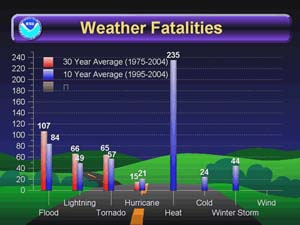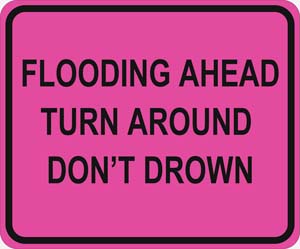| NOAA Magazine || NOAA Home Page |
FLOODS
COST LIVES AND BILLIONS OF DOLLARS IN PROPERTY DAMAGE EACH YEAR AROUND
THE UNITED STATES
2005 Hurricanes Particularly Devastating to Life and Property
NOAA Reminds Everyone about Flood Safety Awareness
 March
29, 2006 � Across the United States each year many lives are taken or
put at risk by flooding. In every state or territory floods destroy
property costing billions of dollars annually. NOAA National Weather
Service storm data
show that on average floods kill more people every year than lightning,
tornadoes and hurricanes. In 2005, inland flooding from hurricanes Katrina
and Rita caused an extraordinary loss of life and property damage. (Click
NOAA image for larger view of weather fatalities chart covering a 30-year
period from 1975 to 2004. Please credit “NOAA.”)
March
29, 2006 � Across the United States each year many lives are taken or
put at risk by flooding. In every state or territory floods destroy
property costing billions of dollars annually. NOAA National Weather
Service storm data
show that on average floods kill more people every year than lightning,
tornadoes and hurricanes. In 2005, inland flooding from hurricanes Katrina
and Rita caused an extraordinary loss of life and property damage. (Click
NOAA image for larger view of weather fatalities chart covering a 30-year
period from 1975 to 2004. Please credit “NOAA.”)
How do you protect yourself against the dangers of floods? The NOAA National Weather Service has extensive tips and programs to help get the word out about flooding and ways to save lives and property.
| News
Audio (mp3) |
| Tom Graziano, acting chief of the NOAA Hydrologic Services Division, part of the National Weather Service, on cars washed away by flood waters. :19 |
| Graziano on fatalities and property damage due to floods. :40 |
| Graziano on the "Turn Around, Don't Drown" program and flood dangers. :32 |
| Graziano on having a plan to protect life and property from floods. :41 |
| NOAA Weather Radio All-Hazards simulated tornado warning. :49 |
Podcast
4:51 |
Tom Graziano, acting chief of the NOAA Hydrologic Services Division, part of the National Weather Service, says the greatest tragedy about flooding deaths is that most of them can be avoided if people just didn't try to drive through flooded roads. "A lot of times when you approach a water-covered roadway you don't know how fast the water is moving. You don't know how deep it is. You don't even know if there's a roadbed underneath. In fact, it only takes about six inches of moving water to sweep a person off their feet, and as little as two feet of water to sweep an automobile, including SUVs, downstream.”
Whether its ice jams, rapidly melting snow, torrential thunderstorms or slow-moving tropical storms, floods are a threat across the USA year round. Graziano said the NOAA National Weather Service continuously tries to educate the public about the dangers posed by floods and safety measures to protect life and property. He said that during the very intense 2005 Atlantic hurricane season, flooding associated with two hurricanes in particular, took hundreds of lives and caused property damage in the tens of billions of dollars.
"What the numbers tells us that we're losing about over 100 people a year and in excess of four-and-a-half billion dollars in damages,” said Graziano. “Now, that does not include Fiscal Year 2005 where the deaths and damages far exceed those numbers, and that's the direct result of hurricanes Katrina and Rita. In fact, we on an annual basis compile the flood loss statistics for the Corps of Engineers, and our preliminary data for Fiscal Year 2005 indicated flood losses in excess of 40 billion dollars and the loss of life in the vicinity of a thousand folks. So, it was a particularly bad year in large part the results of the combine effects of those two hurricanes."
 The
NOAA National Weather Service has a public education and outreach program
that informs people across the nation about weather-related hazards,
including the threat posed by floods. In addition, Flood Safety Awareness
Week, held in March, emphasizes the dangers of floods and what people
can do to protect themselves. Graziano said, "There is a very real
threat, and when people don't heed that threat or recognize that threat
then often times the results can be disastrous. So, what we've done
is we've begun this campaign called "Turn
Around, Don't Drown" to educate and inform people that when
they approach a water-covered roadway simply to turn around and drive
the other way." (Click NOAA illustration for larger view
of flooding safety awareness road sign. Please credit “NOAA.”)
The
NOAA National Weather Service has a public education and outreach program
that informs people across the nation about weather-related hazards,
including the threat posed by floods. In addition, Flood Safety Awareness
Week, held in March, emphasizes the dangers of floods and what people
can do to protect themselves. Graziano said, "There is a very real
threat, and when people don't heed that threat or recognize that threat
then often times the results can be disastrous. So, what we've done
is we've begun this campaign called "Turn
Around, Don't Drown" to educate and inform people that when
they approach a water-covered roadway simply to turn around and drive
the other way." (Click NOAA illustration for larger view
of flooding safety awareness road sign. Please credit “NOAA.”)
Graziano says there are a number of things people can do before a flood poses a risk, including having a NOAA Weather Radio All-Hazards with fresh batteries.
"Find out if you're located in a high, medium or low flood risk area. Check with your local, city or county government to find out if your community is participating in the National Flood Insurance Program. Start with the building or planning department to review flood insurance rate maps, which are published by the Federal Emergency Management Agency. Develop an evacuation plan,” he said. Everybody in the family should know where to go if you have to leave, and make sure that after you develop it you discuss it with family members. Everybody should know what to do in case family members get separated. Determine if the roads that you normally travel to reach your home or job will be flooded during a storm."
 Protecting
life and property is the mission of the NOAA National Weather Service.
Knowing what to do to protect yourself and loved ones from the dangers
of floods before, during and after can save lives, reduce injuries and
property damage. For more information about flooding, please visit the
NOAA National Weather Service Web site at www.floodsafety.noaa.gov.
(Click NOAA image for larger view of flooding safety awareness
road sign from the “Turn Around, Don’t Drown” program.
Click here for high resolution
version. Please credit “NOAA.”)
Protecting
life and property is the mission of the NOAA National Weather Service.
Knowing what to do to protect yourself and loved ones from the dangers
of floods before, during and after can save lives, reduce injuries and
property damage. For more information about flooding, please visit the
NOAA National Weather Service Web site at www.floodsafety.noaa.gov.
(Click NOAA image for larger view of flooding safety awareness
road sign from the “Turn Around, Don’t Drown” program.
Click here for high resolution
version. Please credit “NOAA.”)
NOAA, an
agency of the U.S. Department of
Commerce, is dedicated to enhancing economic security and national
safety through the prediction and research of weather and climate-related
events and providing environmental stewardship of the nation's coastal
and marine resources.
Through the emerging Global Earth Observation System of Systems (GEOSS),
NOAA is working with its federal partners and nearly 60 countries to
develop a global monitoring network that is as integrated as the planet
it observes.
Relevant Web Sites
NOAA Hydrologic
Services Division
NOAA Natural Hazard Statistics
Media
Contact:
Chris Vaccaro, NOAA
National Weather Service, (301) 713-0622 ext. 142